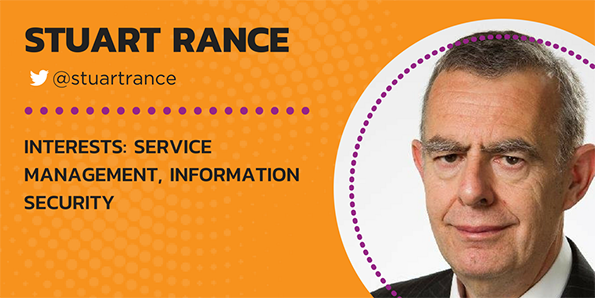Date Published May 24, 2017 - Last Updated December 6, 2017
In January 2017, HDI presented the Top 25 Thought Leaders in Technical Support and Service Management. To help you get to know them better and learn what it means to be a community leader, we’ve interviewed each of our thought leaders. Today, we hear from Stuart Rance.

Tell us about your day job and also how you are involved in the community.
I have the best job in the world. I do a wide variety of different things and no two days are the same. I work in both IT service management and information security management, which gives me a wide breadth of different opportunities. I do a lot of writing—books, articles, blogs, web content etc.—for a wide range of clients. I also do training. I teach ITIL, Resilia, CISSP, and other formal accreditations. I also design and deliver quite a few custom training courses, designed to help change attitudes, behaviour, and culture of staff, as well as increase knowledge and understanding of specific topics. I do a wide range of consulting, usually based on helping organizations understand how they can increase the value they get from their IT investment. I have done improvement planning for ITSM processes, designed of service portfolios, helped clients prepare for external audits of ITSM or information security, and many other things. As I said earlier, every engagement is different and I enjoy a huge variety of different activities.
My community involvement includes blogs, on my own optimalservicemanagement.com site as well as on many other sites. I maintain a list of my blogs and update it regularly. I speak at many events, mainly itSMF conferences, but also other industry bodies and vendor events. These are a great opportunity to network, and I’m always delighted to meet new people and share ideas with them. I’m a regular contributor to the Back2ITSM group on Facebook, which is one of the friendliest social media groups I know, and I am very active on Twitter as @StuartRance.
What motivates you to be active in the community?
I first became engaged in community activity when I worked for a large multinational organization and I was offered the opportunity to lead their 8,000 strong internal ITSM community. I really enjoyed helping people to help each other; there is nothing so satisfying as seeing someone develop and grow in both work and personal areas. Things that I facilitated there include mentoring, webinars, discussion forums, and facilitating groups developing many different aspects of ITSM. Even when I worked for that organization, I recognized that there was value in extending this sharing outside the company. If we share what we know and help each other, then we can all improve together, and that is good for us, for our customers and clients, and for the industry generally.
I have found the ITSM community on social media to be very welcoming, and I have formed many friendships that extend to the physical world. Some people on social media just want to shout about their own achievements, but the vast majority of people want to listen, share, and learn together, and that is the community that I seek out and nurture.
What suggestions do you have for tech support professionals interested in getting more involved in the community?
Think very hard about WHY you want to get involved, WHAT you can contribute, and what you want to get out of it. Make sure you listen to other people more than you speak. Imagine you have walked into a party that started some time ago. Do you want to be the person that stands against the wall and shouts about your achievements, or would it be better to listen to some conversations and join in when you have something helpful to contribute?
As well as joining in the conversations on Twitter and Facebook, you should try to meet up with people at events. If you are attending a conference, find other attendees on social media and arrange to meet up. If you live in a big city, join in the meetups that already take place, or help arrange one if there’s nothing going on yet.
What trends do you anticipate for information security as it relates to service management over the next few years?
I see a huge increase in collaboration across different groups. We hear a lot about DevOps, but this isn’t just about development and operations teams. It must also include security, business, and every other stakeholder. Information security has sometimes been run as a special, separate aspect, but the governance and management need to come together with the governance and management of IT generally and with the business as a whole. Organizations need to think much harder about the way they create value and about end-to-end processes. We don’t want to have multiple incident management processes (for security incidents, IT incidents, business incidents, facilities incidents, etc.) or multiple change management processes (for security, ITSM, business…). These all need to move to integrated processes that focus on creating the best possible value while managing risk.
Information security governance and management need to come together with IT governance and management.

Amy Eisenberg is the editor for HDI where she works with industry experts and practitioners to create content for technical support professionals. She has worked in B2B media and scholarly publishing for more than 20 years, developing content for print and digital magazines, print and email newsletters, websites, conferences, and technical seminars. Follow Amy on Twitter @eisenbergamy, and connect with her on LinkedIn.